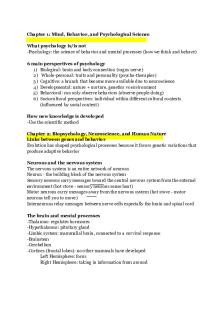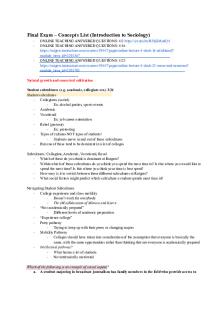Study Guide for Quiz 1: Intro to study of religions PDF

| Title | Study Guide for Quiz 1: Intro to study of religions |
|---|---|
| Author | Miah Fields |
| Course | World Religion |
| Institution | Grand Canyon University |
| Pages | 3 |
| File Size | 94.7 KB |
| File Type | |
| Total Downloads | 78 |
| Total Views | 135 |
Summary
Study guide questions and answers for quiz on the intro to the study of world religions with page numbers and references....
Description
Study Guide for Quiz 1 INT-244 World Religions Topic 1: Introduction to the Study of Religions and Christianity (Note: Page numbers may vary slightly in web version.) 1. According to Winfried Corduan, author of the textbook, Neighboring Faiths, what is the definition of religion? (text, p. 28) A religion is a system of beliefs and practices that by means of its cultus directs a person towards transcendence and thus provides meaning and coherence to a persons life
2. What is the difference between religion and spirituality, according to Corduan? (text, p. 27-28) Religion comes with a cultus, whereas spirituality is a purely personal and private matter that need not show up in any external manner
3. In Corduan’s definition of religion, he uses the term “cultus”. What does this term refer to? (text, p. 27) An external feature, no matter how small, which has meaning only for the sake of the religious belief and would be unnecessary in other contexts. Outward practices 4. From our class study on the topic of “what is religion?” what are the four basic questions each culture or worldview seeks answers to? Where are we? Origin /reality Who are we? Meaning What’s wrong? Morality What is the remedy? Destiny 5.
Corduan, in the textbook, presents two theories of the origin of religion (Evolutionary Model and Original Monotheism). What are the basic views of each approach? (text, p 33, 40) Evolutionary model: proposed that religious thought and practice developed from simpler to more complex forms. Man made Original monotheism: model proposed that all religious traditions can be traced back to an exclusive worship of one God, and other forms of belief are derivative from this original pattern. Began with God
6. List the stages of the Evolutionary Model theory of the origin of religion. (text, p. 33) 1. Mana and magic 2. Animism 3. Polytheism 4. Henotheism 5. Monotheism 7. What are the three primary forms of Christianity that evolved through history, as discussed in the presentation on Early Christian History and your readings? (Lecture; readings) Roman catholic, orthodox, Protestantism 8. What issues divided the Eastern and Western Christians, causing the Roman Catholic churches to separate from the Eastern Orthodox churches. (Lecture; readings) The eastern Christians tended to be more interested in Theological formations while western Christians tended to be more practical and were concerned with survival in a hostile, decaying
world. The largest issue dividing the Eastern and Western Christians was papacy.
9. What were three reasons that the Church of Rome became the focal point of Catholicism? (from class presentation on Early Christianity) – (Lecture; readings) 1. Simon Peter was a Bishop- he believed Jesus gave the assignment to him 2. Constantine moved the seat of the gov. (aka the capital)- this created a void in leadership 3. Eastern Christians were fighting for power – the west and east then split 10. What are the three broad strands of Protestantism that developed in the Reformation? (Lecture) - Luther - Anabaptism - Calvinism 11. List three causes of the revolution that became known as the Reformation. (Lecture) - Beginning of European Nationalism (Roman Empire began to split) - Learning of the Renaissance - Decline in papacy
12. Who was the German Reformer who sought to move the Catholic Church back to Scripture over 500 years ago? (Lecture) Martin Luther
13. Define the terms exclusivism, inclusivism, and pluralisms, as discussed in the textbook and other readings. (Text, p. 55-57; readings) Exclusivism: view that only one religion is true and that all others are false Inclusivism: claims that only one religion is true, but that believers in other religions are included in that one religion and so are either followers of the religion without knowing it or at least receive the benefits of that one religion unbeknownst to them Pluraivism: view that are religions are equally true
14. What can Christians learn from other faith traditions? (INT-244 Topic 1 Overview) Explain your response. Opinion
15. What is one unique teaching that biblical Christianity has, and other religions do not have? (Lecture/Readings) a. Biblical Christianity allows a "folk" form that syncretizes its laws and its doctrines with other religions so that all can get to heaven. b. Only Christians believe that getting into eternal heaven comes through doing enough acts of love to please heaven's rulers. c. Christianity exclusively believes in the Trinity—that the Father sent the eternal Son to earth to satisfy the goodness all people should have and satisfy the punishment due to rebels, and they send the Spirit to cause believers to be born again and live a righteous and good life by faith.
d. Christianity has the simplest evolutionary understanding of earth history because it supports the "Big Bang" theory. 16. Which Roman Catholic understandings differ from Protestant doctrines? (Readings) a. Mary is considered holy and may be prayed to as an intercessor to God. b. The Pope's infallibility in all matters of faith and doctrine when he speaks officially. c. Transformation of the wine and bread into the real body and blood of Jesus. d. All of the above. 17. Define contextualization, according to the class lecture. (Lecture) Maintains core teachings, puts peripheral aspects into languages for all....
Similar Free PDFs

Intro study Guide 1
- 15 Pages

Intro to sociology ch 1 study guide
- 11 Pages

Quiz 1 Study Guide
- 9 Pages

Quiz 1 study guide
- 6 Pages

Quiz 1 Study Guide
- 3 Pages

Quiz 1 Study Guide
- 11 Pages

Chapter 6 Religions Study Guide
- 14 Pages

Microscope Intro Study Guide
- 2 Pages

Intro to Biology Exam 2 study guide
- 11 Pages
Popular Institutions
- Tinajero National High School - Annex
- Politeknik Caltex Riau
- Yokohama City University
- SGT University
- University of Al-Qadisiyah
- Divine Word College of Vigan
- Techniek College Rotterdam
- Universidade de Santiago
- Universiti Teknologi MARA Cawangan Johor Kampus Pasir Gudang
- Poltekkes Kemenkes Yogyakarta
- Baguio City National High School
- Colegio san marcos
- preparatoria uno
- Centro de Bachillerato Tecnológico Industrial y de Servicios No. 107
- Dalian Maritime University
- Quang Trung Secondary School
- Colegio Tecnológico en Informática
- Corporación Regional de Educación Superior
- Grupo CEDVA
- Dar Al Uloom University
- Centro de Estudios Preuniversitarios de la Universidad Nacional de Ingeniería
- 上智大学
- Aakash International School, Nuna Majara
- San Felipe Neri Catholic School
- Kang Chiao International School - New Taipei City
- Misamis Occidental National High School
- Institución Educativa Escuela Normal Juan Ladrilleros
- Kolehiyo ng Pantukan
- Batanes State College
- Instituto Continental
- Sekolah Menengah Kejuruan Kesehatan Kaltara (Tarakan)
- Colegio de La Inmaculada Concepcion - Cebu






